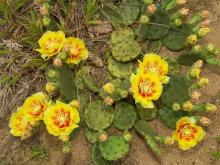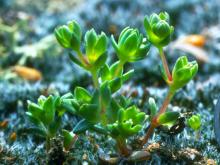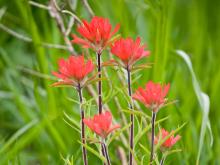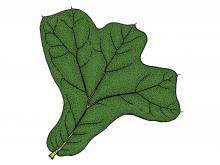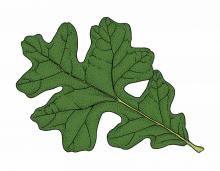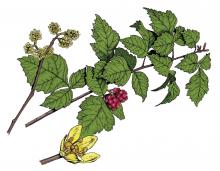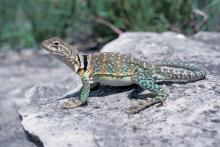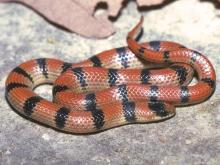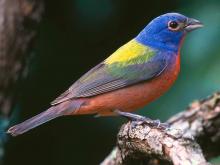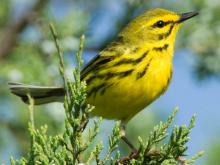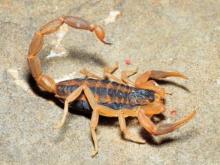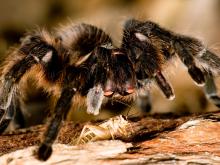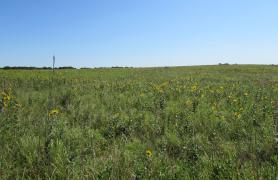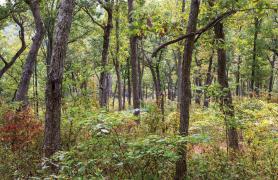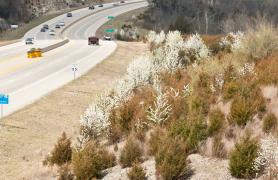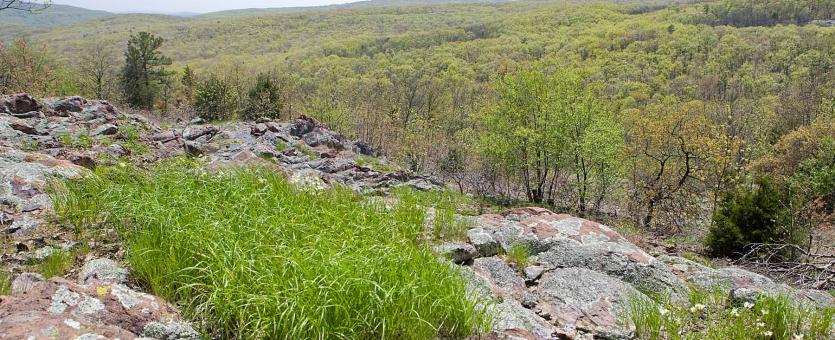
Glades are open, rocky areas usually located amid upland woodlands. Their high location, thin soils, exposed rocks, few trees, and south- or west-facing aspect makes them hot and dry. Plants and animals adapted to our glades will remind you of the desert, or of prairies. Many other plants and animals benefit from glades because of the transition zone between the open, sunny glades and adjoining wooded areas.
Periodic Disturbance Keeps Glades Open
In Missouri’s Ozarks, glades used to be more common than they are now. Historically, lightning strikes, Native Americans, and early settlers occasionally started fires, which kept the glades open and sunny.
With settlement came fire suppression and continuous grazing. The lack of fire and trampled soil allowed eastern red cedar and other trees to overtake many Missouri glades. As thick stands of trees shaded out the sun-loving glade flora, the collared lizards, roadrunners, and other animals began to disappear, too.
This sequence is similar to the situation with prairies, which also eventually turn into forests if periodic fire and grazing don't occur to keep shrubs and trees from taking over.
In addition to fire, other natural disturbances that kept glades open were drought, frost upheaval, and native grazers. Deer, elk, and bison grazed the glades briefly, and then moved on.
As conservationists have learned the role of periodic disturbance in the glade ecosystem, they have begun restoring glades with cedar removal and prescribed fire.
Plants and Animals
Hot, dry conditions plus soil chemistry and other factors limit the types of plants that can survive in glades. This goes for other life-forms, too. Some organisms commonly associated with the desert Southwest or the southern Great Plains find the northeastern limit of their ranges in Missouri. Other plants and animals, more common in balmier southeastern states, find their northwestern limits in Missouri’s glades.
First among glade plants, drought-tolerant lichens and mosses cling to the rocks. Several glade plants are especially adapted to the desertlike conditions — prickly pear cactus, glade and yellow coneflowers, prairie dock, compass plant, wild petunia, and Missouri evening primrose, bladderpod, and geocarpon all have special mechanisms for surviving drought. Many warm-season grasses and other plants we commonly associate with prairies are often found on glades: little bluestem, sideoats grama, switchgrass, and prairie dropseed, for example.
Many fascinating animals live on glades, including several amphibians and reptiles such as the eastern narrow-mouthed toad, southern coal skink, six-lined and prairie racerunners, Great Plains ratsnake, flat-headed snake, eastern (red) milksnake, eastern collared lizard, eastern coachwhip, and several more. Many of these are secretive, keeping cool under rocks during the heat of day.
Birds associated with glades include roadrunner, yellow-breasted chat, painted bunting, Bachman’s sparrow, field sparrow, brown thrasher, and prairie warbler. Before they moved into cities, where they nest on the hot, dry tops of buildings, common nighthawks once built their nests on the warm rocks of glades.
Texas and desert mice are especially noted for living in glades, but many other mammals thrive when glades occur in their woodland habitats, providing warm sunny spots on cold days, and a patch of grasses, forbs, and relatively abundant insects to eat.
A host of insects, spiders, and other invertebrates occur specially on glades. Like the amphibians and reptiles, many stay hidden in crevices or under rocks: the striped bark scorpion, Texas brown tarantula, black widow, and harvestmen (daddy longlegs) are notable. The lichen grasshopper is restricted to glades, but many other grasshoppers (some of them rare or threatened), beetles, flies, ants, and bees are strongly associated with glades. Several butterflies, skippers, and moths are common on glades, and the Ozark swallowtail, Papilio joanae, is primarily restricted to Ozark glades. Missouri’s largest tiger beetle, Cicindela vulturina, lives only in dolomite glades in the White River Hills.
Five Types of Glades
Glade communities are distinguished by their underlying rock type, which strongly influences the soil chemistry. Igneous, chert, and sandstone glades, for example, tend to have acidic soils, while dolomite and limestone glades are calcified, with alkaline or neutral soils. Soil type is a big influence on which kinds of plants grow there.
The different bedrock types appear as outcrops in different regions of the Ozarks, so the five different glade types occur in different regions, too. To see examples of all Missouri’s glade types, you’ll have to travel around the state!
1. Limestone Glades
Limestone glades occur mainly in southwestern Missouri, along the west and north borders of the Ozark Highlands. They are much less common than dolomite glades, which are somewhat similar. Most limestone glades are relatively small in acreage and are typically located above rivers and streams.
Calcium leaches out of limestone and dolomite, so glades on those bedrocks have alkaline or neutral soils. With similar soils, limestone and dolomite glades have many plants in common, and many of these are also associated with prairies. Little bluestem, sideoats grama, Mead’s sedge, wild onion, prairie dock, and Missouri coneflower are common to both. Limestone glades are especially noted for prairie tea, orange puccoon, narrow-leaved milkweed, eastern prickly pear, dwarf spiderwort, Missouri primrose, false aloe, and more.
2. Dolomite Glades
Dolomite glades beautify much of the Ozarks. Widespread and abundant, they are found nearly throughout the Ozarks, but they are concentrated in Barry, Stone, Taney, and Ozarks counties in the southwest, and Jefferson County in the east. They usually dot south- and west-facing slopes in hilly landscapes, and they are usually separated from each other by expanses of woodland and forest.
Some dolomite glades are up to several hundred acres in size. As dolomite erodes, its horizontal layers create a stairstep or blocky pattern. Their many nooks and crannies offer hiding places for small animals to hide or for plants to root.
The calcium that leaches out of dolomite raises the soil’s pH, so the plants the live on dolomite glades must be able to live in these alkaline or neutral soils. Look for Missouri black-eyed Susan, yellow coneflower, Missouri evening primrose, scurfy pea, prairie turnip, and many grasses usually associated with prairies: little and big bluestem, sideoats grama, and switchgrass.
3. Chert Glades
Chert glades are very rare in Missouri and are found only in the extreme southwest part of the state; in fact, only about 20–60 acres of this habitat remains, most of it within the city limits of Joplin. The soils are especially shallow and acidic, so the plants and animals are quite specialized. Because chert weathers so slowly, there are few crevices to serve as shelters for animals. Historically, chert glades were probably grazed by bison and elk, and the fires that kept trees from encroaching on these glades apparently reached them by spreading from nearby prairies and savannas, which are also maintained naturally by fire.
As in the other acidic glades, lichens and mosses are abundant. Common plants include sedums, selenia, Venus’ looking glass, eastern prickly pear, aromatic aster, dwarf dandelion, pinweed, and Barbara’s buttons. Say’s grasshopper (Spharagemon equale), with gray-tan camouflage but bright yellow-orange legs, in Missouri is apparently found only on chert glades.
4. Sandstone Glades
Sandstone glades occur mostly along the edges of the Ozark dome, scattered across the northern half of the Ozark Highlands, with more dense communities on the west and north Ozark border. They are similar to igneous glades, but because sandstone weathers and erodes differently, sandstone glades have a smooth, less rugged appearance. They are usually gently sloping or flat and occur lower within the landscape than other glade types. They also tend to be smaller in terms of acreage. Often, there are shallow temporary pools following rain or snowmelt.
As with other glades with acidic soils, sandstone glades have extensive areas of the bedrock covered by lichens and mosses. Sandstone glades are bordered by dry woodlands with stunted, gnarled trees and shrubs. The rare plant geocarpon, a tiny, succulent member of the pink or carnation family, occurs almost exclusively on sandstone glades in west-central Missouri.
5. Igneous Glades
Igneous glades, which typically have rhyolite and granite bedrocks, occur in southeast Missouri, especially in the St. Francis Mountains and in a few places in the Current River hills. They are usually situated on hilltops, so they provide some of the most spectacular views of the Ozarks. They vary in size from less than an acre to broad expanses of 30–40 acres. The hard, insoluble rocks are often exposed, creating a rugged terrain. Dry woodlands with stunted, gnarled trees and shrubs often occur at the edges of these glades.
The irregular nature of igneous bedrock creates occasional deep pockets in which soils can develop. Igneous glades have many plants in common with the similarly acidic sandstone glades. Look for plants like blue curls, rock pink, sundrops, and more. Lichens and mosses are plentiful, but grasses typically are not the dominant plants.
Most of Missouri’s glades are south of the Missouri River in the Ozark Highlands, plus some counties in the Mississippi River hills. There are currently about 400,000 acres of glades in our state, out of the estimated half a million acres that existed at the time of European settlement.
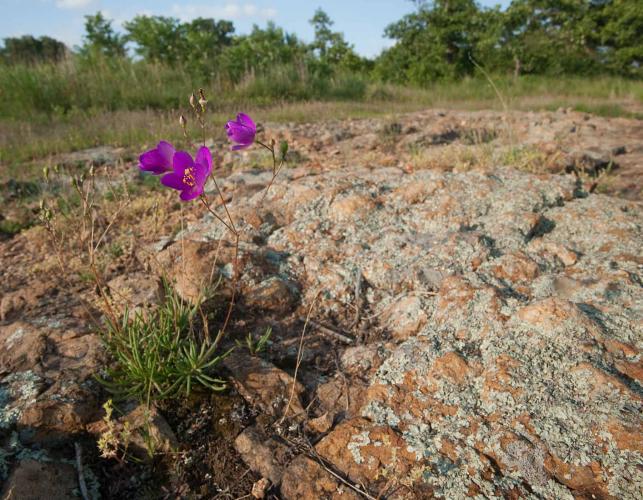
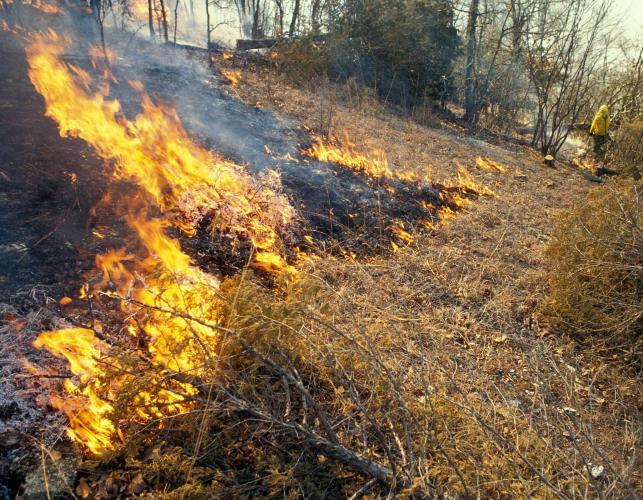
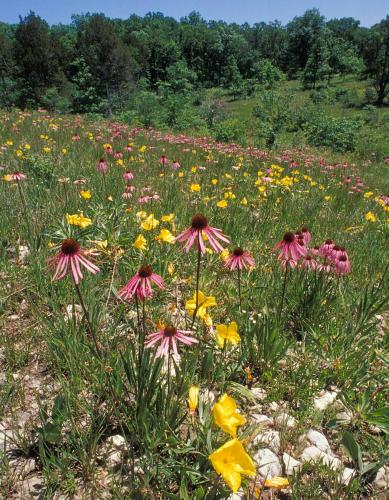
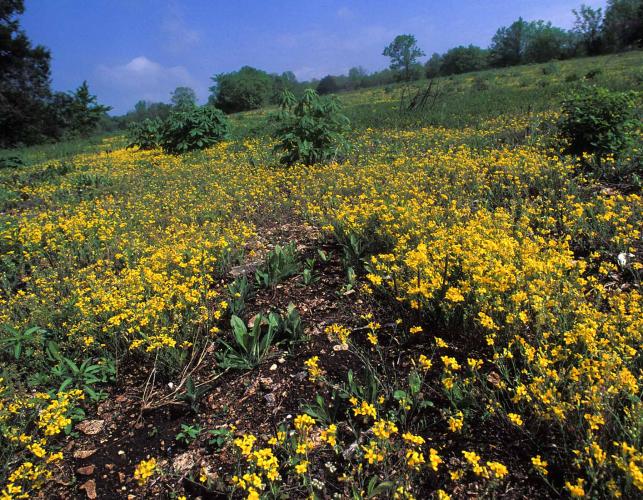
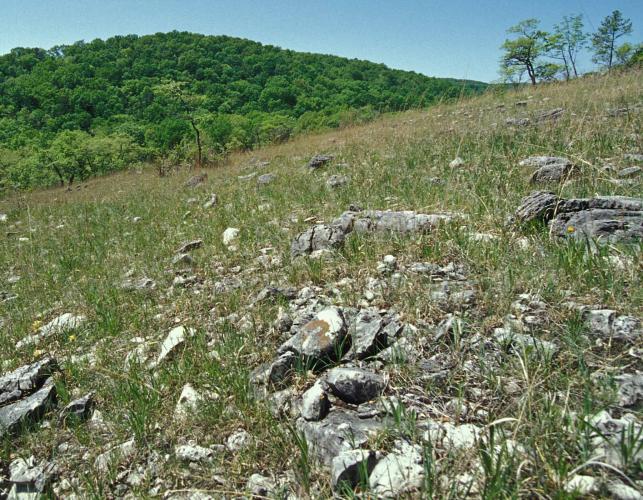
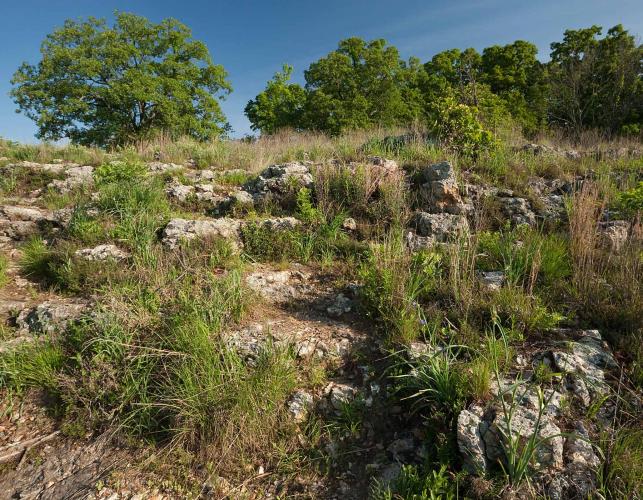
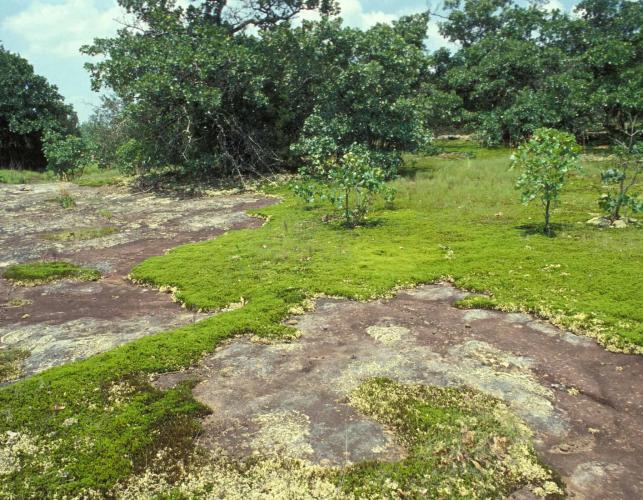

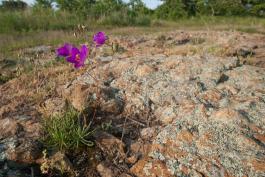
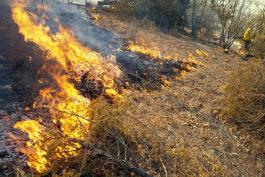
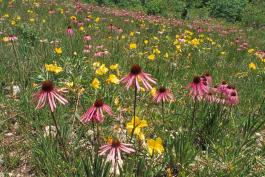
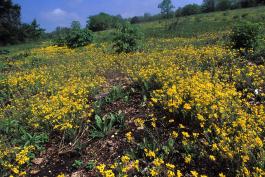
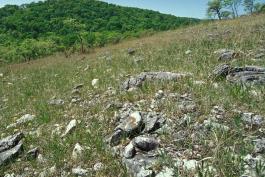
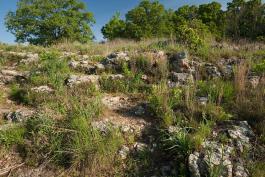
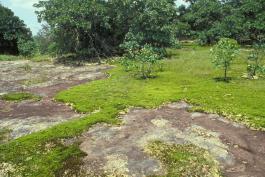
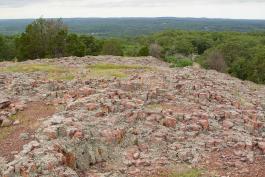
Key species
